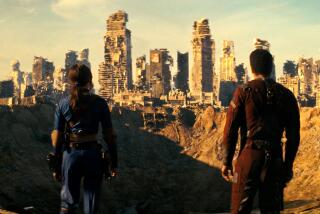‘Martian’ production designer details making the Rover, habitat and all that sand

“We made the set soil look like Jordanian desert, which looked just like Mars,” says Arthur Max, the production designer who created “The Martian’s” look.
This isn’t Arthur Max’s first trip to the rodeo, or even into space. “The Martian” marks the production designer’s 11th collaboration with director Ridley Scott. Oscar-nominated for “Gladiator” and “American Gangster,” Max has degrees in science, art and architecture, which came in handy here — as did his research with scientists at the Jet Propulsion Laboratory, NASA and the European Space Agency. And some experience playing in the sand.
The shock about “The Martian” isn’t how fantastical it all looks, but how believable.
It’s near future. It’s based on the technology that he needs to manipulate to survive, so we had to get it right. The design is integral to the plot. So his knowledge of botany, organic chemistry, the engineering of rocket travel, telemetry, all those things, I don’t really have a very good knowledge of but I had to learn. I’m sure a lot of people say that making films isn’t rocket science, but “The Martian” is. It has to be because it’s all about the detail, the minutiae, all the machinery — the life support systems, the navigation equipment, the Rover. Let’s talk about the Rover.
SIGN UP for the free Indie Focus movies newsletter >>
Let’s.
The United States government is spending tens of millions on developing prototypes for the Rover, which look nothing like our Rover, because we didn’t think it looked, well, cinematic enough. It’s much more of a practical vehicle in research, they’re not concerned with the aesthetic at all, but it had certain aspects to it that we adopted. But also it would only go about three or four miles an hour, top speed. Ours went 25 miles an hour.
You filmed outside in Jordan, and then at a huge indoor set in Budapest.
Huge. We filled the set with a thousand metric tons of three different colored sands. It was like a kind of blend of coffee. “The Martian” blend. We looked at Mars through the eyes of Curiosity, the current JPL-built and manipulated probe, which sent back the best photographs of the surface of Mars ever. And we said, “Well, that looks just like Jordan.” We’d filmed in Jordan several times before — on “Prometheus” and “Exodus: Gods and Kings.” So we made the set soil look like Jordanian desert, which looked just like Mars. I have to confess, we never went to Mars on this movie.
You mean it was a fake mission to Mars?
It was a representational mission to Mars.
What was the biggest challenge in adapting the actual technology to the film?
When I went to NASA and JPL, one of the bigger issues is about shielding against solar and cosmic radiation, and in order to do that, they just use bulk. Everything is heavy and thick and dark. So one makes crucial assumptions, and I’ve always done that with Ridley for any genre: What you don’t know, you can invent. One can presume that in 15 or 20 years, there will be a material that will be reflective to the point that it will not allow too much sun or cosmic rays in, but just enough light so you can function without a lot of artificial lighting, or gloom. So we had a translucent roof on the habitat for lighting. It also helped him grow his potatoes.
How did you create the rest of his habitat?
You make a flow diagram like a good architectural designer, and you put all the functions that have to take place within it. With Mars, or any interplanetary space travel, it ultimately comes down to payload: What can you afford to get into orbit to put together and send off into space? It’s all about budget, like making a film. You want it to be as packed as possible, as lightweight as possible, but you don’t want anybody to die inside of it, so it has to have a life-support system — heating, ventilation, water supply, toilet, shower, such as they are. For shower facilities, they told me at NASA, they use Handi Wipes.
For a year?
Well, yeah. So that’s what he’s got to do for more than a year. And conserve water because it’s in short supply. Although the day the film opened, they announced that they discovered that there’s water on Mars.
That was the best marketing any studio has ever come up with.
They knew that prior but they hadn’t confirmed it because they had to do more testing to be certain, with the Curiosity. They said that several meters under the ground, there are huge supplies of water. But they’re frozen, and also briny, so you’d have to distill it anyway to drink it.
You’ve done so many genres. Do you have a favorite?
The one I haven’t done yet.
Is there an era you’re dying to try?
I would love to do a 1920s, ‘30s, ‘40s or ‘50s East Coast gangster movie. Please, anybody out there.
More to Read
From the Oscars to the Emmys.
Get the Envelope newsletter for exclusive awards season coverage, behind-the-scenes stories from the Envelope podcast and columnist Glenn Whipp’s must-read analysis.
You may occasionally receive promotional content from the Los Angeles Times.








